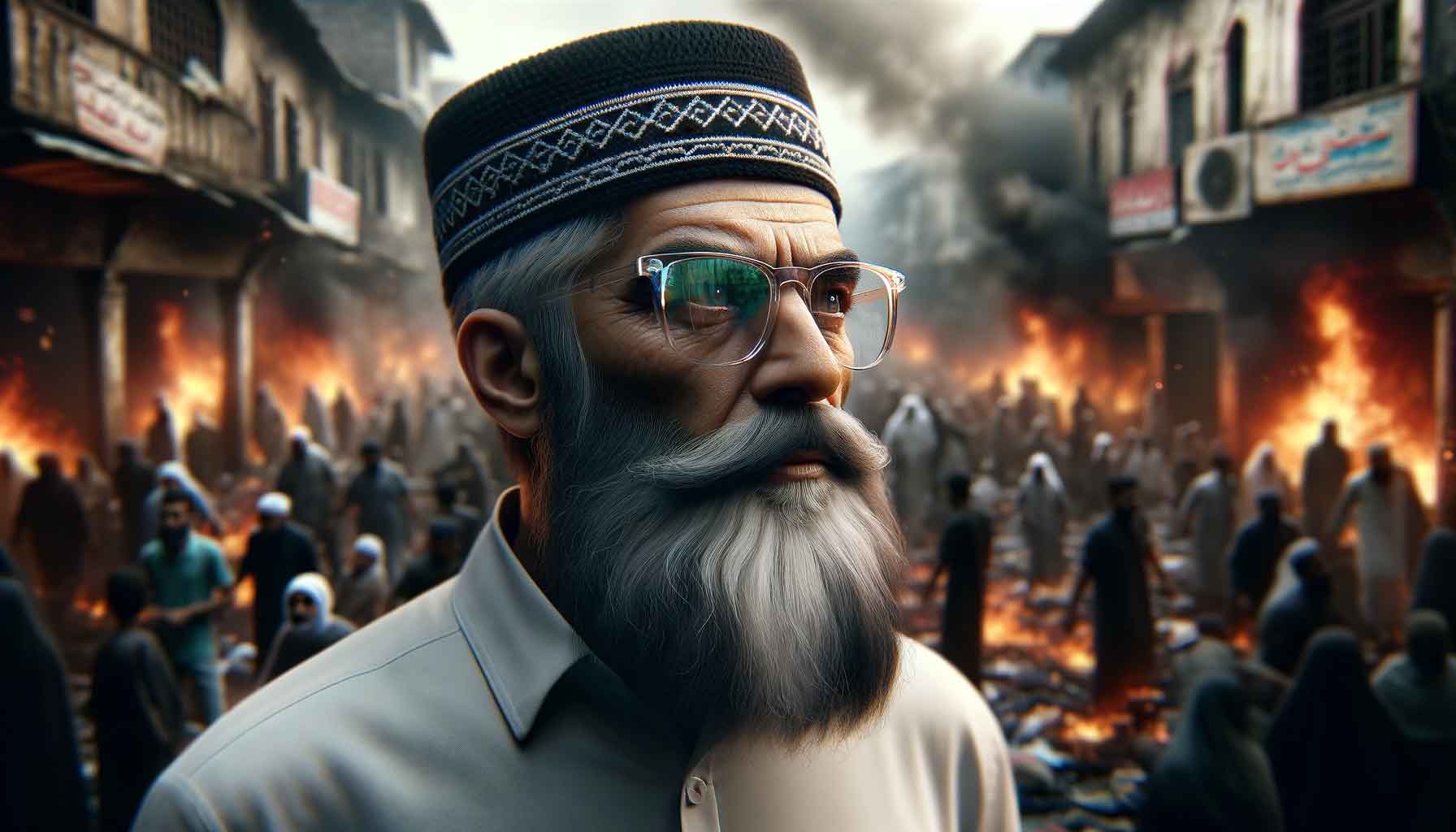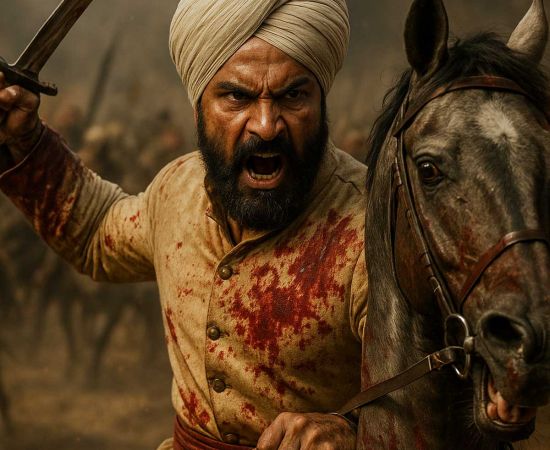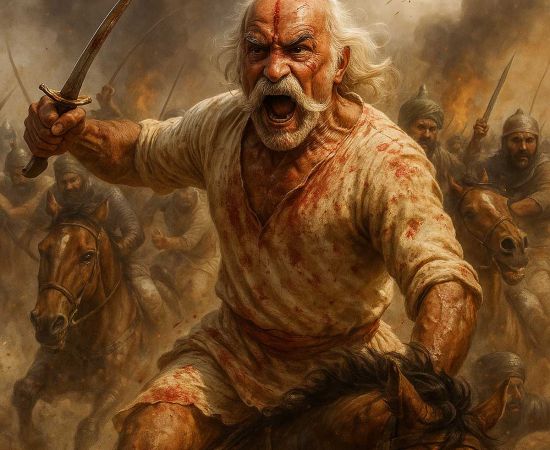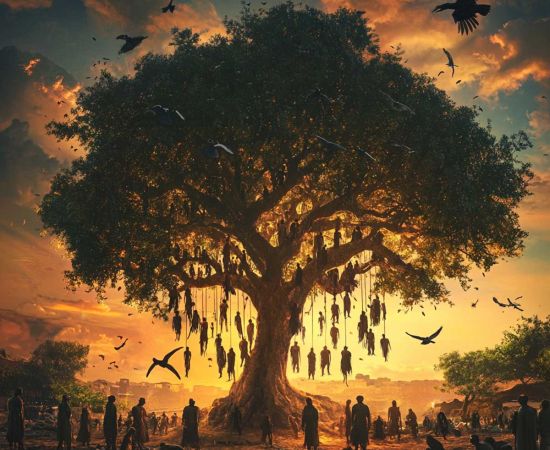MORE COVERAGE
Twitter Coverage
Satyaagrah
Written on
Satyaagrah
Written on
Satyaagrah
Written on
Satyaagrah
Written on
Satyaagrah
Written on
JOIN SATYAAGRAH SOCIAL MEDIA
”I will shed rivers of blood of Hindus”: UP court declares Maulana Tauqeer Raza Khan as the mastermind behind the 2010 Bareilly riots, exposing a calculated assault on Hindus through a diverted procession, armed mobs & communal chants incited by his words

In a significant development, the Additional Session's Judge Court in Uttar Pradesh has officially recognized Maulana Tauqeer Raza Khan as the principal orchestrator of the devastating riots that targeted Hindus in Bareilly back in 2010. The court has called upon the controversial cleric to appear before it on the 11th of March concerning his role in the violence.
The city of Bareilly was plunged into chaos in 2010 when what began as a Muslim Barawafat procession went awry. The group, initially following a predetermined path, made a sudden and forceful detour into a Hindu-majority area. This unexpected move sparked widespread violence and arson, primarily driven by participants identified as Islamists. The severity of these actions was such that it effectively paralyzed the city, imposing a curfew that lasted for an extended period of over ten days.
Documents and evidence examined during the court proceedings shed light on Maulana Tauqeer Raza Khan's significant influence over the events that unfolded. Investigations and reports, including those conducted by OpIndia, have unearthed detailed accounts of the Muslim procession. Not only were participants armed, but they also engaged in inflammatory communal chants. It is reported that it was Maulana's incendiary speech that incited the crowd, leading to a horrifying spree of violence against the Hindu community.
In the turmoil that engulfed Bareilly during the 2010 riots, it wasn't just the Hindu community that found themselves at the mercy of the violence. The Sikh population, along with other minority groups, suffered significant losses too. BJP Member of Parliament SS Ahluwalia brought this distressing fact to the attention of the Parliament, highlighting the particular plight of Sikh business owners. Many Sikh families, having migrated from Punjab and neighboring areas after the harrowing anti-Sikh riots of 1984, sought refuge and a new beginning in Bareilly. Unfortunately, their hopes for peace were shattered as their establishments and livelihoods became targets during the riots, mirroring the tragedies they had hoped to leave behind.
Heading - Unveiling the Significance of the Barawafat Procession
The Barawafat procession, a central religious event for the Barelvi sect of Sunni Muslims, takes place in Bareilly, a city revered for hosting the most sacred site of the Barelvi community - the Bareilly Sharif Dargah, also known as Dargah-e-Alahazrat. This procession is held in commemoration of Milad-un-Nabi, the birthday of Prophet Mohammad, and sees the city come alive with devout participants.
Groups, or anjumans, consisting of approximately 100-150 individuals each, take to the streets in a display of faith and devotion. With over 100 such anjumans participating, a grand procession emerges, weaving its way from Kohadapeer towards the central shrine. This significant march is meticulously organized by the Anjuman Khuddama Rasool Tanzeem (AKRT), following a predetermined route that symbolizes a collective homage to the Prophet Mohammad.
The Unfolding of the 2010 Anti-Hindu Bareilly Riots
On the day of March 2, 2010, a significant event took place in Bareilly as a large group of Barelvi Muslims gathered for a Barawafat procession, a deeply rooted religious observance marking the birthday of Prophet Mohammad. This day, however, would also be remembered for the ensuing discord that erupted in the city.
During the procession, a pivotal moment arose when one of the Muslim groups unexpectedly altered their course. Originally intended to pass through the Prem Nagar area, they instead headed towards the Kohada Peer locality. This abrupt deviation sparked immediate tension among the Kohada Peer residents, signaling the onset of unrest.
Further complicating the narrative, another report, drawing from The Bareilly Jagran's coverage, indicated that the procession was initially slated to traverse the Kohara Peer area. Yet, in a turn of events around 3 pm, the direction was changed by the participants to go through the Chahbai area instead. These variations in accounts converge on one critical point: the procession's pre-approved path by the district administration was deliberately altered by the participants.
This contentious route alteration is believed to have been influenced by a preceding administrative decision. The district authorities had opted to delay the procession, originally scheduled for February 27, to March 2, in consideration of the Holi festival celebrated on March 1. This decision to postpone, aimed at avoiding any overlap with Holi celebrations, inadvertently set the stage for the conflict that followed.
Adding another layer to the events, there were critiques aimed at the then-Mayawati government for permitting a second Barawafat procession to occur.
The events of March 2010 in Bareilly were preceded by a significant occasion on February 27th, when Muslims commemorated the birthday of Prophet Mohammad with a procession. Despite this, a subsequent procession was scheduled for March 2nd, an action that has since been scrutinized for its rationale and implications.
The decision by local authorities to permit this second procession has sparked debate, as highlighted by the Organiser. The critical question posed centers around the administration's decision-making process: "Here the intention of the local administration becomes doubtful why it granted permission for the second procession when one procession had already been allowed?" This query casts a shadow of doubt on the judgment and intentions behind allowing a subsequent event, especially given the prior occurrence.
Reflecting on past incidents provides further context to the situation. A similar episode unfolded in 2006, where attempts to route the Barawafat procession through the Kohada Peer area were met with opposition from local residents. This led to the selection of an alternate path, demonstrating an awareness of the potential for conflict in this area.
Despite this historical backdrop, the 2010 procession, under the governance of the BSP-led administration, proceeded with plans that seemed to overlook previous tensions. The procession deviated from its agreed path and made its way towards the Kohada Peer area, a move anticipated to provoke local dissent. True to fears, the procession's attempt to pass through the area was met with resistance from the residents.
The ensuing clash between the residents and the Muslim mob participating in the procession escalated rapidly. The confrontation turned violent, with locals being manhandled, and stones thrown in response to their objections. The chaos did not spare public property; police outposts, shops, and vehicles were engulfed in flames. The situation deteriorated further with reports of gunfire.
The Kabutarkhana market bore witness to severe destruction, with nearly 20 shops falling victim to arson. The Kohada Peer police station was not spared either; it was set ablaze, and even a temple within the police station suffered desecration, its idol destroyed. The violence inflicted injuries upon several police officers, marking a day of turmoil and loss for the community.
A report from Bareilly Jagran sheds light on a particularly harrowing aspect of the violence. The Muslim mob, driven by fervor, forcefully made their way into the homes of local residents. What followed was a scene of sheer terror as they set gas cylinders within these houses ablaze, causing explosions that not only endangered lives but also stoked the flames of fear across the community.
The unrest was not contained to just the Kohada Peer area; it rapidly spread to other parts of the city including Subhash Nagar, Kotwali, Baradari, Qila, and Prem Nagar. In response to the rapidly escalating situation, local authorities were compelled to declare a curfew. This measure aimed at quelling the violence remained in effect for an extended period of at least 14 days.
Despite the stringent curfew, the violence persisted with incidents of small-scale firing and stone pelting reported until late into the night on March 2nd. Eyewitness accounts, largely absent from mainstream media coverage at the time and even to this day, highlight the mob's alarming level of armament.
One particular account emphasizes the desperate situation faced by the police who found themselves overwhelmed by an armed mob. According to a post on the blog rajeev2004, "The police was, obviously, not able to do anything as they were encountering a mob with weapons. To add fuel to fire, there was stone pelting on temples from the aggressive mobilized minority which lead to retaliations from the majority community."
The violence of that day left an indelible mark on those who witnessed it firsthand, with the severity of the events prompting one observer to make a stark comparison: "I literally saw Bareilly turning into Pakistan that day…there were just green flags and people swinging swords everywhere on the street. When the police tried to stop the crowd and fired in air, the mob went on a rampage," as recounted in the blog. This vivid description paints a picture of a city under siege, grappling with anarchy and despair, emblematic of the intense sectarian divide that had manifested so destructively.
Mahesh Sharma, a resident from the Kotwali area—one of the locations most severely affected—provides a telling account: "It was a deliberate attempt of the communal elements to provoke the sentiments of Hindus. The sequence of incidents and changing the route of the procession despite specific directions from the local administration and the public display of arms and raising communally sensitive slogans throughout the route of the procession fomented the communal clash." This statement underscores the calculated nature of the actions that led to the escalation of conflict, highlighting the manipulation of religious sentiments to incite discord.
The tangible consequences of the riots were devastating, with reports indicating that over 60 Hindu homes were completely destroyed by fire. The human toll was also significant, with at least ten individuals sustaining serious injuries. Beyond the immediate physical and emotional distress, the economic damage was staggering, with property losses amounting to crores of rupees. A particularly distressing aspect of the violence was the targeted nature of the vandalism carried out by Muslim mobs. This unchecked destruction effectively held the city hostage, exacerbating the sense of fear and helplessness among its residents.
In the wake of these events, BJP leader Rajesh Aggarwal expressed his views, specifically noting the selective targeting and destruction of property. "Welcoming the court’s order," Aggarwal pointed out a chilling strategy used during the riots: while Hindu-owned shops bore the brunt of the attacks, Muslim-owned establishments were reportedly spared, identified by green flags placed atop them. This act of marking shops served as a grim indicator of communal division, ensuring that the violence was directed solely towards Hindu properties. Additionally, efforts to mitigate the damage, such as calling in fire brigade services to extinguish the fires, were allegedly obstructed, preventing them from reaching the Hindu-owned shops.
Despite the imposition of a curfew lasting two weeks, designed to restore order and peace, the unrest continued in other forms. Muslim mobs reportedly issued stark warnings to the government led by Mayawati and the local administration, particularly concerning the arrest and subsequent release of Maulana Tauqeer Raza, identified as the mastermind behind the riots.
|
The Role of Maulana Tauqeer Raza in Escalating Bareilly's Sectarian Violence
In a significant judicial development, Maulana Tauqeer Raza Khan, recognized as the founder of the All India Muslim Personal Law Board (Jadeed) and the Ittehad-e-Millat Council (IMC), has been pinpointed by a Uttar Pradesh court as the key figure behind the Bareilly riots. The court's findings reveal that Maulana played a pivotal role in orchestrating the violence that shook the city.
According to the court's documentation, Maulana Tauqeer Raza took deliberate steps to escalate tensions during the period of unrest. He notably had a platform constructed within the Kohada Peer area from which he delivered a speech filled with hate, effectively inciting the crowd that had gathered. His words proved to be a catalyst, as the mob, fueled by the Maulana's speech, launched an attack on the police forces stationed nearby. The violence escalated to the point where the Kohada Peer police station was besieged, and the sacred idols within a temple on its premises were desecrated.
The rioters, spurred by Maulana's incitement, targeted Hindu residences and businesses in a series of attacks that bore the hallmarks of terrorism. Armed with gas cylinders and petrol bombs, they unleashed chaos, underlining the severity of the Maulana's influence on the mob's actions.
Further insights from the court case reveal Maulana's explicit threats towards the administration and the Hindu community. He is reported to have issued a stark warning: "I will shed rivers of blood of Hindus. I will set their (Hindus’) homes and shops on fire," if his demands regarding the procession route were not met. This statement, as highlighted by the court, serves as a damning indication of his intentions and his role in prompting the outbreak of riots across Bareilly.
The court's conclusion firmly establishes Maulana Tauqeer Raza Khan not just as a participant, but as the mastermind behind the targeted anti-Hindu violence that ensued. His actions and words, as detailed in the court's findings, underscore the deliberate nature of the incitement that led to the widespread unrest and destruction within the city.
|
In the proceedings that followed the Bareilly riots, the court expressed astonishment at a significant oversight: the absence of Maulana Tauqeer Raza Khan's name from the chargesheet. This omission highlighted a concerning gap in the legal documentation related to the case.
The situation took a turn for the worse with the arrest of Maulana Tauqeer Raza Khan on March 8th, four days subsequent to the outbreak of violence. This action sparked a renewed wave of unrest among the Muslim community, leading to further episodes of violence and vandalism. The response was not just limited to physical expressions of dissent; Muslim groups issued political threats against the BSP government, warning of a potential boycott of Mayawati’s political rallies, thereby targeting her electoral support base.
The effectiveness of the security measures in place was severely questioned as the Muslim mob demonstrated their defiance. Their actions were not confined to the period following Maulana's arrest; even after his release three days later, on March 11th, the violence persisted. Police personnel once again found themselves the target of aggression, sustaining injuries as the mob resumed their rampage. This continued unrest over two weeks, during which the state appeared largely inactive, further exacerbated the situation.
The decision to release Maulana Tauqeer Raza Khan did not go without criticism from the local legal community. The Bareilly Bar Association publicly condemned the move, arguing that it undermined the integrity of the judicial system. They contended that the local administration’s handling of the situation effectively ridiculed the principles of justice, prompting some lawyers to express their disapproval directly to the then Chief Minister Mayawati. This wave of criticism underscores the deep divisions and the complex interplay of legal, political, and social factors in the aftermath of the Bareilly riots.
 |
 Support Us
Support Us
Satyagraha was born from the heart of our land, with an undying aim to unveil the true essence of Bharat. It seeks to illuminate the hidden tales of our valiant freedom fighters and the rich chronicles that haven't yet sung their complete melody in the mainstream.
While platforms like NDTV and 'The Wire' effortlessly garner funds under the banner of safeguarding democracy, we at Satyagraha walk a different path. Our strength and resonance come from you. In this journey to weave a stronger Bharat, every little contribution amplifies our voice. Let's come together, contribute as you can, and champion the true spirit of our nation.
 |  |  |
| ICICI Bank of Satyaagrah | Razorpay Bank of Satyaagrah | PayPal Bank of Satyaagrah - For International Payments |
If all above doesn't work, then try the LINK below:
Please share the article on other platforms
DISCLAIMER: The author is solely responsible for the views expressed in this article. The author carries the responsibility for citing and/or licensing of images utilized within the text. The website also frequently uses non-commercial images for representational purposes only in line with the article. We are not responsible for the authenticity of such images. If some images have a copyright issue, we request the person/entity to contact us at This email address is being protected from spambots. You need JavaScript enabled to view it. and we will take the necessary actions to resolve the issue.
Related Articles
- Islamists have long employed violence as a strategic tool of contention to exact obedience, assert their hegemony, and silence their critics: Here’s what Islamists have achieved with their veto on street violence
- UP Police deployed Bulldozer forced kingpin of a car theft syndicate Nasiruddin to spill out the secrets of his illicit business: Accused revealed all his accomplices Shahid, Riajul, Imran, Furkan, and Armaan
- Jodhpur witnesses rampant violence on Eid as mob goes on a rampage after Namaz: Muslim mob replaced Bhagwa flag with an Islamic flag at Jalori intersection
- Violent protests broke out by Islamists in Jharkhand capital of Ranchi over the alleged ‘blasphemous’ comments by Nupur Sharma, as per police the protests gathered pace after Friday Namaz
- Charges framed against Tahir Hussain by Delhi Court for Delhi Anti-Hindu riots 2020: 5 accomplices, active participant, used own house for throwing stone, patrol bombs etc., elaborate preparations to target Hindus
- NDMC to bulldoze “illegal encroachments” in Delhi's Jahangirpuri where riots broke out against Hindu devotees: Tukde tukde gang supporter AAP’s Amanatulah Khan says ‘attempt to disrupt peace during Ramzan’
- Far-left activist Yogendra Yadav's party leader Gulab Pasha demands to change the route or deny permission for Hindus to hold annual Annamma Devi procession: Claims it will disturb harmony between communities
- ‘Sarkar ko Jhukana and, Hindu-musalman karwana hai… Need to finish Hindus, make a separate nation for Muslims’: Govt counsel continues to present scathing evidence to oppose bail to Umar Khalid
- Gujarat MLA Jignesh Mevani made the Pushpa ‘Jhukega Nahi’ signature move after being re-arrested by the Assam Police: Jahangirpuri accused Ansar also had made the same move
- "In our pursuit of peace, technology is our sword and justice our shield": Amidst Nuh's violent unrest, CM Khattar's firm stance resonates: culprits will compensate for the damage, DRDO's facial recognition system could potentially unmask the perpetrators
- Bulldozer out to teach a lesson to criminals, rioters who create unrest in the society: Razed off all the shops near the dargah in Khambhat where stone-pelting took place on the chariots in Rath Yatra procession, Gujarat
- Sleeper cell module was activated in pre-planned violence to establish dominance of Muslim community so Hindus don't dare to take out Shobha Yatras in future: Stones collected and kept on route of yatra ahead of time
- 'Anti-Hindu Delhi riot was remotely supervised by Umar Khalid just like 9/11 conspirators,’ prosecutors oppose Khalid’s bail plea, says 'Riot key conspirators were like entertainers who resorted to damrubaazi to attract crowd'
- Stone pelting from the rooftops on Hanuman Jayanti procession in Jahangirpuri, police vehicles torched, used firearms to attack police: Ambush on Hindu holy expedition continues in the country, one policeman shot
- Left-liberal journalists attempt to whitewash Islamists' attack on Hanuman Jayanti procession of Hindus fall flat after Viral video shows the moment when the Shobha yatra was attacked first near a mosque in Jahangirpuri



























